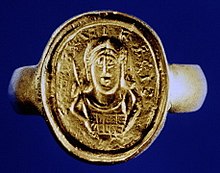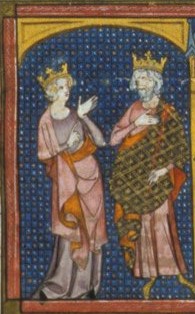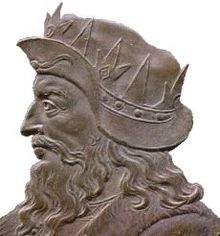
Amalberge (Saint Amalaberga) before 674, daughter of Wandregisis and Farahild.
Clovis II (637 – 27 November 657 or 658) succeeded his father Dagobert I in 639 as King of Neustria and Burgundy.

Saint Balthild of Ascania (/ˈbɔːltɪld/;[2] Old English: Bealdhild, 'bold sword' or 'bold spear; around 626 – January 30, 680), also called Bathilda, Baudour, or Bauthieult, was the wife and queen of Clovis II, the king of Burgundy and Neustria (639–658). Herhagiography was intended to further her successful candidature for sainthood.[3]
Tradition represents her as an Anglo-Saxon who was originally of elite birth, perhaps a relative of Ricberht of East Anglia, the lastpagan king of East Anglia, although Pierre Fournet regards this as doubtful.[4] Ricberht was ousted by Sigeberht, who had spent time as an exile in the Frankish court, during which he had been converted to Christianity. Sigeberht was established as the rightful heir to the throne with Frankish help. Balthild was sold into slavery as a young girl and served in the household of Erchinoald, the mayor of the palace of Neustria to Clovis.

Dagobert I (c. 603 – 19 January 639) was the king of Austrasia (623–634), king of all the Franks (629–634), and king of Neustriaand Burgundy (629–639). He was the last king of the Merovingian dynasty to wield any real royal power.[1] Dagobert was the first of the Frankish kings to be buried in the royal tombs at Saint Denis Basilica.[2]
Dagobert was the eldest son of Chlothar II and Haldetrude (575–604)

Nanthild (c. 610 – 642), also known as Nantéchilde, Nanthechilde, Nanthildis, Nanthilde, or Nantechildis, was a Frankish queen consort and regent, the third of many consorts ofDagobert I, king of the Franks (629–639).
She was of Saxon lineage, born about 608 or 610.
Chlothar II (or Chlotar, Clothar, Clotaire, Chlotochar, or Hlothar; 584–629), called the Great or the Young, was King of Neustria andKing of the Franks, and the son of Chilperic I and his third wife, Fredegund

Bertrude (ca. 582–618 or 619) was a Frankish queen consort from 613 to 618. She was married to Chlothar II.

Chilperic I (c. 539 – September 584) was the king of Neustria (or Soissons) from 561 to his death. He was one of the sons of theFrankish king Clotaire I and Queen Aregund.

[1]Fredegund (or Fredegunda) (Latin: Fredegundis; French: Frédégonde) (died 597) was the Queen consort of Chilperic I, theMerovingian Frankish king of Soissons.
Fredegund was born into a low-ranking family but gained power through her association with King Chilperic.[1] Originally a servant of Chilperic's first wife Audovera, Fredegund won Chilperic's affection and persuaded him to put Audovera in a convent and divorce her. Gregory of Tours remarks that Fredegund brought with her a handsome dowry, incurring the immediate affection of King Chilperic.[2] But Chilperic then put Fredegund aside and married Galswintha. Galswintha died the same year, probably strangled by Fredegund[3](c. 568), who succeeded Galswintha as queen. Galswintha's sister, Brunhilda, however, began a feud which lasted more than 40 years.

Chlothar I[1] (c. 497 – 29 November 561), called the Old (le Vieux), King of the Franks, was one of the four sons of Clovis I of theMerovingian dynasty.

Aregund, Aregunda, Arnegund, Aregonda, or Arnegonda (c. 515/520–580) was a Frankish queen, the wife of Clotaire I, king of the Franks, and the mother of Chilperic I of Neustria. She was the sister of Ingund, one of Clotaire's other wives. Ingund and Aregund were the daughters of Baderic, King of Thuringia.

Clovis (Latin: Chlodovechus; reconstructed Frankish: *Hlodowig;[1] c. 466 – c. 511) was the first king of the Franks to unite all of theFrankish tribes under one ruler, changing the form of leadership from a group of royal chieftains to rule by a single king and ensuring that the kingship was passed down to his heirs.[2] He is considered to have been the founder of the Merovingian dynasty, which ruled the Frankish kingdom for the next two centuries.
Clovis was the son of Childeric I, a Merovingian king of the Salian Franks, and Basina, Queen of Thuringia,

Saint Clotilde (475–545), also known as Clothilde, Clotilda, Clotild, Rotilde etc. (Latin Chrodechildis, Chlodechildis from Frankish *Hrōþihildi or perhaps *Hlōdihildi, both "famous in battle"), was the second wife of the Frankish king Clovis I, and a princess of the kingdom of Burgundy. Venerated as a saint by the Catholic Church, she was instrumental in her husband's famous conversion to Catholicism and, in her later years, was known for her almsgiving and penitential works of mercy.
Clotilde was born at the Burgundian court of Lyon, the daughter of King Chilperic II of Burgundy. Upon the death of Chilperic's father King Gondioc in 473, he and his brothersGundobad and Godegisel had divided their inheritance; Chilperic II apparently reigning at Lyon, Gundobad at Vienne and Godegesil at Geneva.[

Childeric I (French: Childéric, Latin: Childericus; c. 440 – 481/482) was a Merovingian king of the Salian Franks and the father ofClovis I, who would unite the Franks and found the Merovingian dynasty.
Childeric succeeded his father Merovech as king of the Salian Franks,

Basina or Basine (c. 438 – 477) was a queen of Thuringia in the middle of the fifth century.
Basina was a daughter of the Thuringian king Basin and Basina, a Saxon princess.

Merovech (Latin: Meroveus or Merovius) (d. 453/457) is the semi-legendary founder of the Merovingian dynasty of the Salian Franks(although Chlodio may in fact be the founder), which later became the dominant Frankish tribe. His name is close to Marwig, lit. "famed fight" (cf. māri "famous" + wīg "fight"; compare modern Dutch mare "news, rumour" and vermaard "famous").[1] He is said to be one of several barbarian warlords and kings that joined forces with the Roman general Aetius against the Huns under Attila on the Catalaunian fields in Gaul. The first Frankish royal dynasty called themselves Merovingians ("descendants of Meroveus") after him, although no other historical evidence exists that Merovech ever lived.
There is little information about him in the later histories of the Franks. Gregory of Tours only names him once as the father of Childeric I while putting doubt on his descent fromChlodio.[2]

Chlodio (c. 392/395[1]–445[1]/448; also spelled Clodio, Clodius, Clodion, Cloio or Chlogio) was a king of the Salian Franks from the Merovingian dynasty. He was known as the Long-Haired King and lived in Thuringian territory, at the castle of Duisburg. He became chief of the Thérouanne area in 414 AD. From there, he invaded the Roman Empire in 428, defeating a Roman force atCambrai, and settled in Northern Gaul, where other groups of Salians were already settled. Although he was attacked by the Romans, he was able to maintain his position and, 3 years later in 431, he extended his kingdom south to the Somme River in the future Francia. In AD 448, 20 years after his reign began, Chlodio was defeated at Vicus Helena in Artois[2] by Flavius Aëtius, the commander of the Roman army in Gaul.
Like all Merovingian kings, Chlodio had long hair as a ritual custom. His successor may have been Merovech, after whom the dynasty was named 'Merovingian'. The non-contemporary Liber Historiae Francorum says his father was Pharamond, whom many believe to have been a legendary person linked to the lineage sometime in the 8th century. The Chronicle of Fredegar makes Chlodio son of Theudemeres, one of the leaders of the Salian Franks and king of Thérouanne (409–414).

Theodemer (also Theudomer) was a Frankish king. He was the son of the Roman commander Richomeres and his wife Ascyla.
Flavius Richomeres[pronunciation?] (Richomer) was a Frank who lived in the late 4th century. He took service in the Roman army and made a career as comes, magister militum, and consul. He was married to Ascyla, with whom he had a son Theodemer, who became king of the Franks. He was uncle of the general Arbogastes.
No hay comentarios:
Publicar un comentario